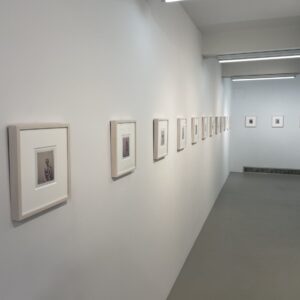JTF (just the facts): Published in 2018 by Jiazazhi Press (here). Softcover, 166 pages, with 77 color photographs. Includes an essay by the artist. In an edition of 500 copies. Design by Pixy Liao and Yinhe Cheng. (Cover and spread shots below.)
Comments/Context: What happens when a man and woman flip the power and sex roles set by a traditional heterosexual relationship? This question resides at the center of Pixy Liao’s work. A Brooklyn-based artist from China, Liao was born in Shanghai, and when she was growing up, she was told that an ideal romantic partner would be someone who was older and more mature, someone who could protect her and be her mentor. But when she met her current husband, Moro, who was five years younger, she had to reconsider her concept of what a relationship looked like. When one of Liao’s Chinese friends suggested that she had chosen a boyfriend who was “younger, prettier and obedient”, her reaction was “Damn right! That’s exactly what I am doing, and why not?!”
Liao first started photographing Moro for her school assignments; she would ask him “to play dead in the bathtub or climb into a suitcase naked”. The reaction of her teachers and classmates, who were rather shocked by the power dynamic in the images, pushed Liao to start experimenting more overtly with the ideas of gender roles and power hierarchies. Moro became an eager collaborator in the project, often contributing his own ideas and suggestions.
Liao’s project has recently been published as a photobook entitled Experimental Relationship Vol 1. (2007-2017). The first thing you notice about the book is how yellow it is: the bright yellow cover matches its yellow edges, and a tiny cut out in the center shows female fingers with red nail polish pinching a male nipple. An abbreviated version of the title – er.1 – is placed next to the hole in blue font. The photographs aren’t sequenced in chronological order, but a thumbnail timeline appears at the end of the book, indicating the four apartments the couple lived in (each with the location and years) and including captions for the images, highlighting the intention behind each setup and Liao’s sharp sense of visual humor.
All of Liao’s photographs are carefully and thoughtfully staged, from the overall concept and composition to the body language, the placement of individual elements, and the color selection. Liao combines a forceful female gaze, intimacy, and a sense of playfulness in her work. Moro often appears naked or wearing minimal clothing, and together with his passive body language, these cues underscore the vulnerability and gentle nature of his character. And when placed with Liao’s obviously dominant and forceful position, the contrast in roles and behaviors is further reinforced.
The book opens with the image we can see through the cut out: Liao and her husband standing next to a window covered with blinds. She wears a red blouse, pants, and red shoes and looks straight into the camera as her fingers touch his nipple, while Moro stands in his white underpants and flip flops looking at her. He holds camera trigger, making it clear that the upcoming narrative is staged, and also setting the terms of the power dynamic. The caption for the image reads, “relationships work best when each partner knows their proper place”. The next few images capture the couple standing in their underwear next to a blank wall, and then lying in bed, immediately clarifying the intimate nature of the relationship. The following spread pairs two very similar pictures: Liao stands in the middle with her camera on tripod holding a trigger, while Moro is behind her on a long reclining chaise; the interior of their apartment serves as a backdrop. The images are titled “photographer and her muse I and II,” and show Moro clothed and then unclothed, like so many models from art history.
The photographs vary in the complexity of their composition and direction. Some of them use a simple gesture to convey Liao’s ideas, while others build more complex narratives and orchestrate more nuanced relationships. A full spread photograph titled “start your day with a good breakfast together” depicts Moro lying on a kitchen table naked as a half of papaya covers his genitals, with a plate with a toast, a glass of juice, and a slice of grapefruit on a plate completing the meal; Liao sits at the table holding a spoon and looking in the camera, ready to eat him up. In another picture, Moro lies on a bed in a bright bedroom with a green scarf enveloping his body and blankets underneath. The piece is titled “home-made sushi” and this is exactly how it looks, the eating motif repeated once again. In still other photographs, Liao carries the naked Moro over her shoulder (with apparent ease), hangs him on a hanger, dresses him up in a lacy shift, and gets a back massage from him, in each case, making the control dynamics clear.
The very last image in the book is placed on the endpaper: Moro and Liao are sitting at an outside table; they both look comfortable and relaxed, representing themselves as they are, reminding us that “the project grows with the real relationship but was never meant to be a documentation.” What makes Liao’s photographs so memorable is the sophisticated way she plays with norms, her setups raising key questions not only about gender roles and the couple’s relationship but also about her work as an artist, the traditional cultural rules that are applied to Chinese women, and the larger female experience. By inverting the usual male/female dynamic and thoughtfully testing its boundaries, she’s found an area for experimentation that feels largely unexplored.
Collector’s POV: Pixy Liao does not appear to have gallery representation at this time. Collectors interested in following up should likely connect directly with the artist via her website (linked in the sidebar).






















